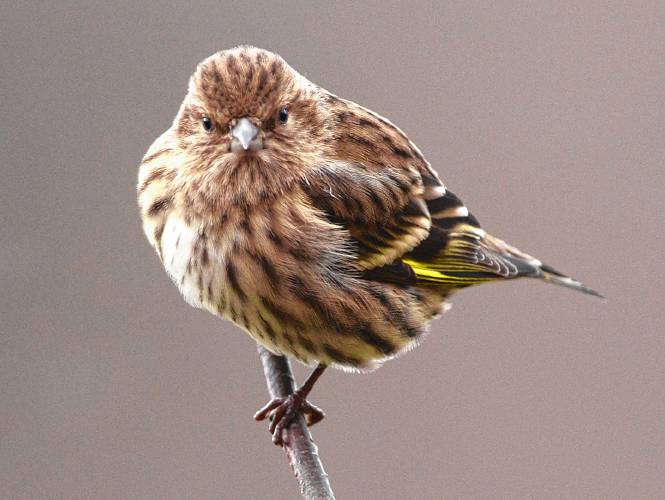Speaking of Nature: No bird record set in November

The beautiful pine siskin is a small bird with a streaked breast reminiscent of a house finch, but a hint of yellow that might suggest an American goldfinch – and an amazing species for anyone’s November list. PHOTO BY BILL DANIELSON
| Published: 12-10-2023 3:34 PM |
I’ll just get straight to the point – it didn’t happen. Try as I might, I was unable to break the record for the number of bird species observed in my yard. For about a week it looked as though my magical record-breaking streak of four consecutive months with four new records might be extended, but luck finally gave out.
That being said, it was a very good month. With more than a little joy, I’ll settle for a tie.
The magic number was 34 species. I own six acres of mixed lawn, meadow, old field and forest, and I have set up some simple rules when it comes to bird observations. I must see or hear the birds from within the confines of my land. Sight can be aided by the use of binoculars.
The most important rule is that I have to adhere to the honor system. I can’t say that I “think” that I saw a certain bird nor can I exaggerate when it comes to sketchy partial songs heard out of the corner of my ear. An identification must be solid or else the whole endeavor is meaningless.
As with any of these lists, the majority of species are what one would call the “regulars,” and they are seen almost without effort on the first day of the month. This year, for instance, I managed to record 18 different species on Nov. 1, which represented more than 50 percent of the species that I needed for the entire effort. These birds included all of the dependable backyard species like American crows, black-capped chickadees, northern cardinals, downy woodpeckers and white-throated sparrows. If you have backyard feeders, you have probably seen all of these birds as well.
By the end of the first week of November, I had managed to bring my list up to 27 species. These were still reliable regulars, but they were the birds that you just don’t see every day. A flock of Canada geese flew over, a pileated woodpecker called out from the woods, and a pair of great horned owls decided to sit on the roof of my house and have a very long discussion one night. This is all very predictable, and it always makes the first week of the month exciting. How close can I get in just one week?
So, I had the last three weeks of November to observe just eight more species. This sounds like a piece of cake, but it is those last few species that always represent a major challenge. All of the low-hanging fruit has been collected, and now we must hope that something interesting and unexpected happens. I even made a list at the bottom of my data form in which I identified the difference between the record year (2018) and this year. This is when things got really interesting.
One of the species that I had seen in 2018 was a pine siskin. This is one of those rare visitors in November that can make or break a list. On Nov. 9, I saw (and photographed) a lone siskin among a flock of American goldfinches. I crossed it off the 2018 list. The same thing happened with a Cooper’s hawk on Nov. 10, and with a song sparrow the same day.
Article continues after...
Yesterday's Most Read Articles
 Bridge of Flowers in Shelburne Falls to open on plant sale day, May 11
Bridge of Flowers in Shelburne Falls to open on plant sale day, May 11
 Serious barn fire averted due to quick response in Shelburne
Serious barn fire averted due to quick response in Shelburne
 $12.14M school budget draws discussion at Montague Town Meeting
$12.14M school budget draws discussion at Montague Town Meeting
 As I See It: Between Israel and Palestine: Which side should we be on, and why?
As I See It: Between Israel and Palestine: Which side should we be on, and why?
 Greenfield homicide victim to be memorialized in Pittsfield
Greenfield homicide victim to be memorialized in Pittsfield
 ‘We are among the leaders’: Ashfield Town Meeting voters pass bevy of clean energy proposals
‘We are among the leaders’: Ashfield Town Meeting voters pass bevy of clean energy proposals
Then I added some “X-factor” species to the 2023 list when I saw (and photographed) a Carolina wren and a yellow-bellied sapsucker on Nov. 19. Surely this was a sign that a new record was in the bag, but that is when the luck ran dry. In the end, in my opinion, it all boiled down to a species that could easily be described as reliable, but for one reason or another things just didn’t work out. It was the common raven, and I just wasn’t outside at those random times when one flew over or croaked out its call from off to the south.
The difference between the years was simple. In 2018, I saw a common merganser fly over the yard, a flock of wild turkeys walk past the house, a northern flicker, an American tree sparrow, and at least one purple finch at my feeders, and that common raven. In 2023, I heard that pair of great horned owls on the roof of my house, I saw a pileated woodpecker fly across my meadow, there was a red-breasted nuthatch at my feeders, I saw a flock of cedar waxwings in my cottonwood tree, and then the aforementioned Carolina wren and yellow-bellied sapsucker on my deck. Each year had six species that were not seen in the other. So close! The most agonizing thing about this was wondering which bird actually visited my yard while I was at work or while I was away for Thanksgiving.
In the end, I have nothing to complain about. It has been a superb year for birding, and I can rightfully claim to have had a spectacular run of five consecutive record months in the second half of the year.
July, August, September and October saw new records set, and November saw the all-time record matched. Not bad at all, but certainly there is a hint that expectations may need to be managed for 2024. Some of those records are formidable, and it is unlikely that I will be able to even tie all of them.
Still, that’s where the fun lies. Get a bunch of birders together on a gorgeous summer evening and start telling war stories. “By Darwin’s beard it was a good year, but nothing will be as good as ‘23!”
Bill Danielson has been a professional writer and nature photographer for 26 years. He has worked for the National Park Service, the U.S. Forest Service, the Nature Conservancy and the Massachusetts State Parks and he currently teaches high school biology and physics. For more in formation visit his website at www.speakingofnature.com, or go to Speaking of Nature on Facebook.

 Speaking of Nature: Indulging in eye candy: Finally, after such a long wait, it’s beginning to look like spring is here
Speaking of Nature: Indulging in eye candy: Finally, after such a long wait, it’s beginning to look like spring is here Celebrating ‘Seasonings’: New book by veteran preacher and poet, Allen ‘Mick’ Comstock
Celebrating ‘Seasonings’: New book by veteran preacher and poet, Allen ‘Mick’ Comstock Faith Matters: How to still the muddy waters of overthinking: Clarity, peace and God can be found in the quiet spaces
Faith Matters: How to still the muddy waters of overthinking: Clarity, peace and God can be found in the quiet spaces A time for every purpose under heaven: Free sing-a-long Pete Seeger Fest returns to Ashfield, April 6
A time for every purpose under heaven: Free sing-a-long Pete Seeger Fest returns to Ashfield, April 6
